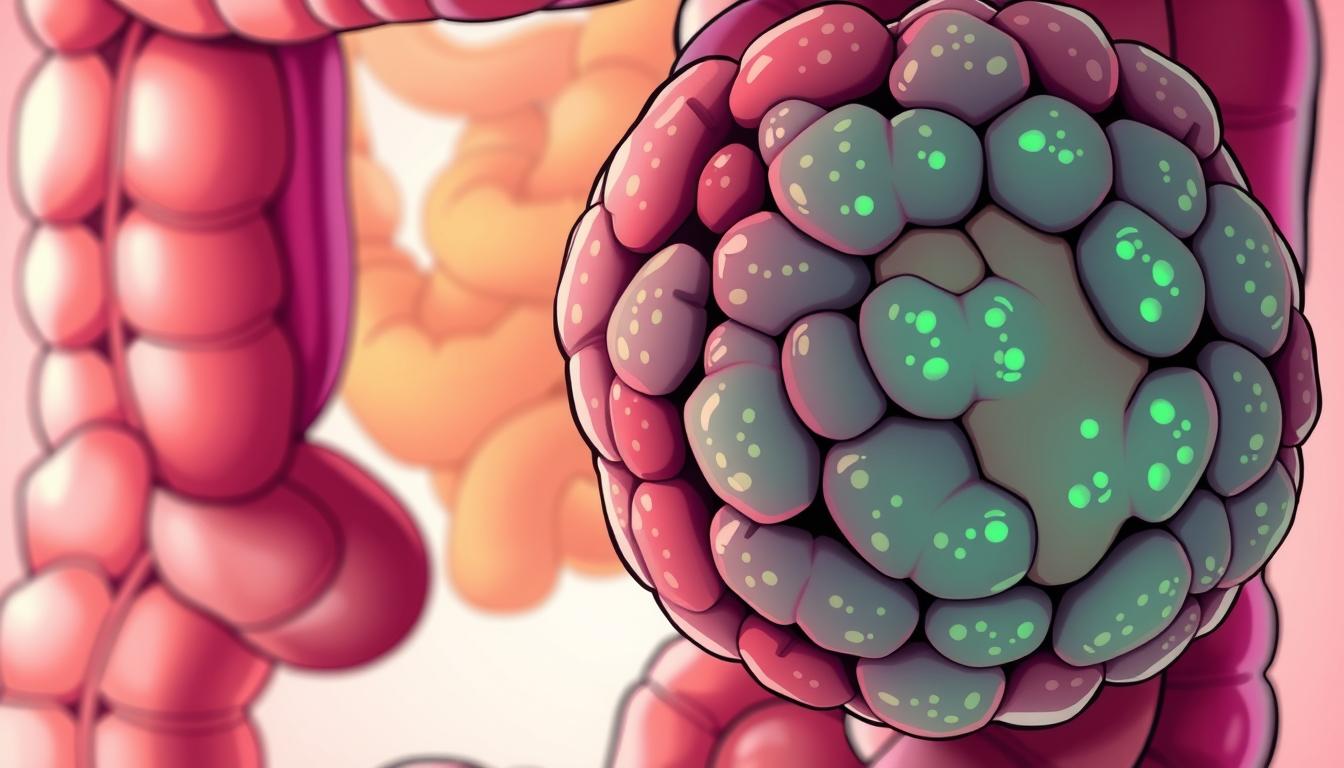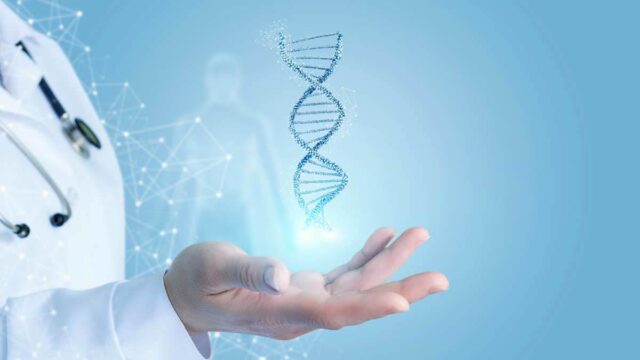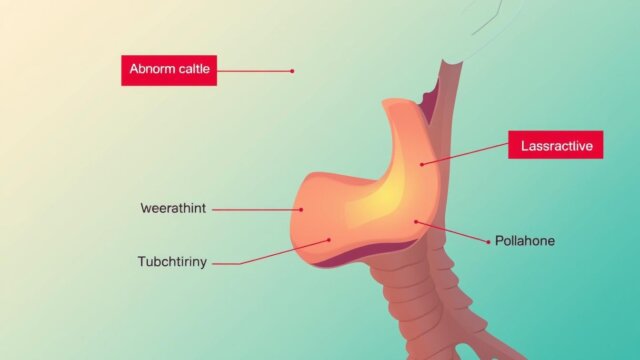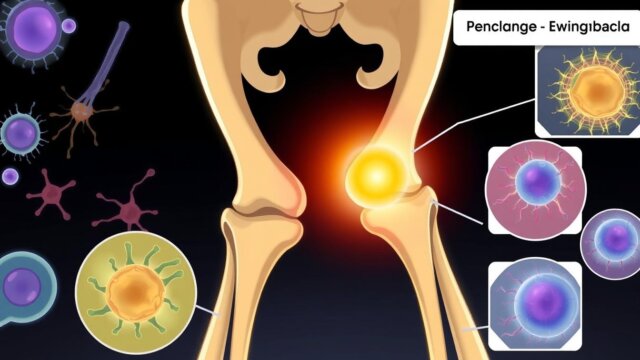FTC disclaimer: This post may contains affiliate links and we will be compensated if you click on a link and make a purchase.
Did you know most carcinoid tumors come from random genetic changes, not inherited ones? This rare cancer often starts in the digestive tract or lungs. It grows slowly and can be hard to find early.
As you learn about carcinoid tumors, you’ll discover their causes, symptoms, and new treatments. These changes are making it easier to manage these cancers.
Key Takeaways
- Carcinoid tumors are a rare type of cancer that arises from neuroendocrine cells and often grow slowly.
- Sporadic genetic changes cause most carcinoid tumors, while a small portion is linked to inherited gene mutations.
- Symptoms can vary widely, from asymptomatic to carcinoid syndrome, which includes flushing, diarrhea, and breathing difficulties.
- Diagnosis often requires a combination of imaging tests, biopsies, and hormone level measurements.
- Treatment typically involves a mix of surgical, medical, and targeted therapies tailored to the individual patient and tumor characteristics.
What are Carcinoid Tumors?
Overview of Carcinoid Tumors
Carcinoid tumors are rare and unique. They can grow in different parts of the body, like the digestive tract and lungs. These tumors start from special cells called neuroendocrine cells, which make hormones and have nerve functions.
They are part of a bigger group called neuroendocrine tumors (NETs). Carcinoid tumors often don’t show symptoms until they grow a lot.
Gastrointestinal carcinoid tumors are more common in African Americans than Caucasians. They are also more common in women than men. These tumors are usually found in people aged 55 to 65 because they grow slowly.
Most carcinoid tumors don’t make hormones. But some do, causing problems known as carcinoid syndrome.
Carcinoid tumors can grow slowly or quickly. The fast-growing ones might spread to other parts of the body. Carcinoid syndrome is rare but can happen if the tumor spreads.
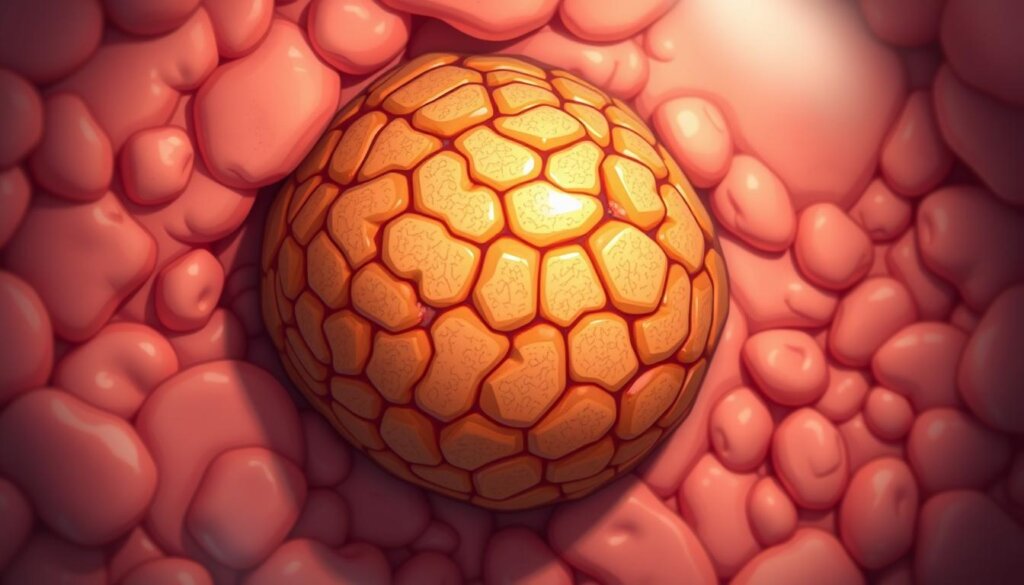
To find carcinoid tumors, doctors use many tests. These include X-rays, CT scans, MRIs, and DOTATATE PET/CT scans. They also do biopsies, urine tests, and blood tests.
Treatment for carcinoid tumors depends on the tumor’s size, location, and stage. For small, local tumors, surgery is usually the first choice.
“Carcinoid tumors are a rare and unique type of neuroendocrine tumor that can develop in various parts of the body, most commonly the digestive tract and lungs.”
Symptoms of Carcinoid Tumors
Carcinoid tumors are a type of neuroendocrine tumor. They can grow in the lungs and digestive tract. At first, they might not show any symptoms. But as they grow, they can cause many signs and symptoms.
Lung carcinoid tumors can cause chest pain, wheezing, and shortness of breath. They can also lead to diarrhea and skin flushing. Digestive tract carcinoid tumors can cause abdominal pain, diarrhea, and nausea. They can also cause vomiting, bowel obstructions, and rectal bleeding.
In some cases, these tumors can release too much hormone. This can cause a condition called carcinoid syndrome. Symptoms include diarrhea, breathing problems, rapid heartbeat, and weight loss.
Not everyone with carcinoid tumors will show all symptoms of carcinoid syndrome. This makes it hard to diagnose. Symptoms can also change based on the tumor’s location and stage. They can also depend on how the body reacts to the excess hormones.
If you’re experiencing these symptoms, see your doctor right away. Early treatment can greatly improve your life and health.

Research is still going on to understand what causes carcinoid tumors. Smoking and diet might play a role, but it’s not clear yet. Carcinoid crisis is a rare but serious condition that can happen in some people with carcinoid syndrome.
Tumor Location | Common Symptoms |
|---|---|
Lung | Chest pain, wheezing, shortness of breath, diarrhea, skin flushing |
Digestive Tract | Abdominal pain, diarrhea, nausea, vomiting, bowel obstructions, rectal bleeding |
Carcinoid Syndrome | Diarrhea, breathing difficulties, rapid heartbeat, weight loss |
In summary, carcinoid tumors can have different symptoms based on where they are. Some people might get carcinoid syndrome, which is more serious. It’s important to know these symptoms and get medical help early. This can help manage the condition better.
Causes and Risk Factors
The exact causes of carcinoid tumors are not fully understood. They are believed to develop from DNA mutations in neuroendocrine cells. These cells are found throughout the body and have both nerve and hormone-producing functions. While most carcinoid tumors occur sporadically, certain genetic conditions like multiple endocrine neoplasia type 1 (MEN1) and neurofibromatosis type 1 can increase the risk.
Causes of Carcinoid Tumors
Carcinoid tumors are estimated to be caused by inherited mutations of the MEN1 gene in about 5% to 10% of cases. Most of these are gastric carcinoids. People with the MEN1 syndrome have a 50/50 chance of passing it on to their children. Neurofibromatosis type 1, characterized by neurofibromas, also presents a risk factor for developing carcinoid tumors of the small intestines.
Risk Factors for Carcinoid Tumors
Other risk factors include older age, female sex, and medical conditions that affect stomach acid levels. These include pernicious anemia and Zollinger-Ellison syndrome. African Americans show a higher occurrence rate of carcinoid tumors compared to whites, with poorer outcomes. Family history of any cancer, especially first-degree relatives or neuroendocrine/neuroendocrine tumors, may elevate the risk of developing a carcinoid tumor.
Lung carcinoid tumors occur more often in women than in men. White individuals have a higher incidence of lung carcinoid tumors compared to African Americans, Asian Americans, Hispanics, or Latinos. Lung carcinoid tumors are typically found in individuals aged around 45-55 years, slightly younger than the average age for other types of lung cancer. Individuals with multiple endocrine neoplasia type 1 (MEN1) have an increased risk of developing lung carcinoid tumors.
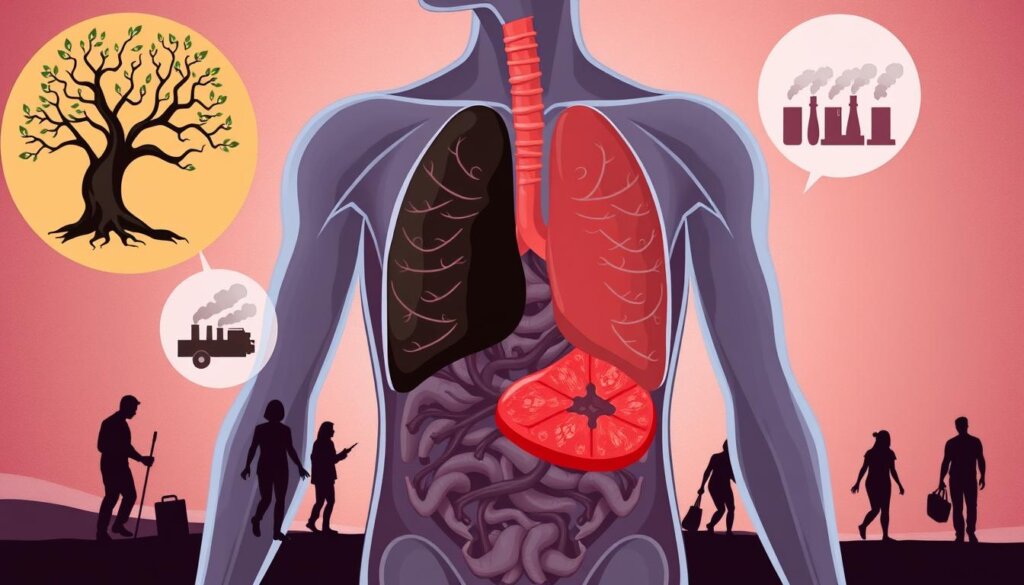
While most people with lung carcinoid tumors do not have a family history of this cancer, a family history of the disease can elevate the risk. Atypical lung carcinoids may be more prevalent in individuals who smoke.
Complications of Carcinoid Tumors
Carcinoid tumors grow slowly but can cause serious problems. One big issue is carcinoid syndrome. It happens when the tumor releases too much serotonin. Symptoms include skin flushing, diarrhea, trouble breathing, and a fast heartbeat.
Carcinoid heart disease is another problem. It happens when hormones make the heart valves and lining thick and scarred. This can lead to heart failure and other heart issues.
Lung carcinoid tumors can also cause Cushing syndrome. This is when the body makes too much cortisol. It can make you gain weight, raise your blood pressure, and cause other metabolic problems.
Studies have investigated how common these problems are. A 2008 study in the U.S. found data on 35,825 cases, and a 2001 study in Sweden examined 22,204 cases. These studies have helped us better understand carcinoid tumors.
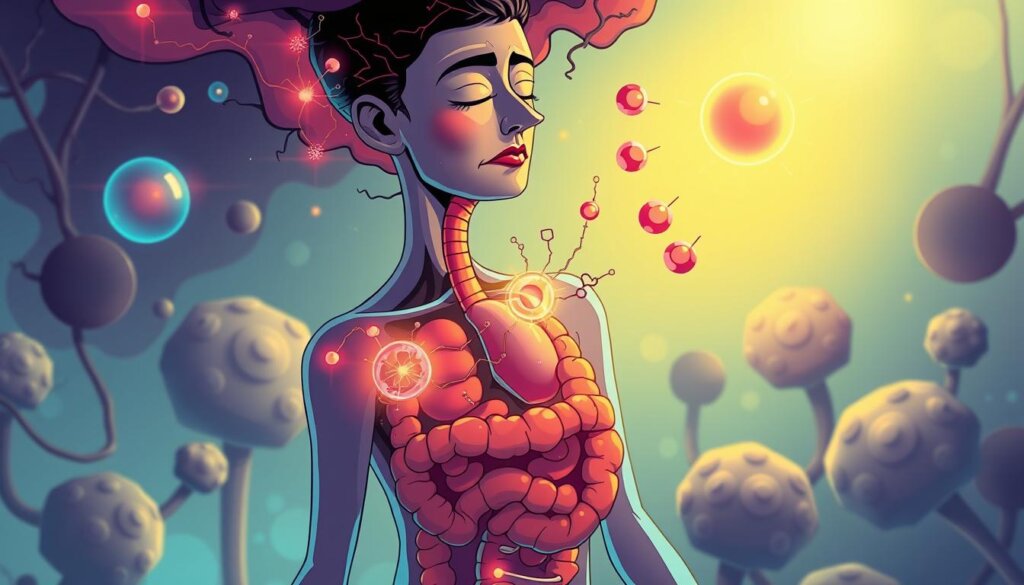
Healthcare providers can help by knowing about these complications. Early detection and treatment are key. They help manage the many problems caused by carcinoid tumors.
Diagnosis of Carcinoid Tumors
Carcinoid tumors can be hard to find because they often don’t show symptoms until later. Doctors use many tests to find and confirm these tumors. These include biopsy, blood and urine tests to check hormone levels, endoscopy or colonoscopy to look at the digestive tract, CT or MRI scans to see the tumor’s size and location, and radionuclide scanning to find somatostatin receptors on the tumor cells.
The barium x-ray is good for finding some GI carcinoid tumors but not those in the small intestine. Computed tomography (CT) scans are mainly used to check the chest and abdomen for tumor spread. Magnetic resonance imaging (MRI) scans are better at finding liver cancer spread than CT scans for GI carcinoid tumors.
The Gallium-68 PET/CT Dotatate scan, approved in 2016, is best for low or intermediate-grade GI carcinoid tumors. It works better than older imaging methods. The I-131 MIBG scan is not often used for GI carcinoid tumors. It usually looks for other types of neuroendocrine tumors.
Endoscopy procedures, like upper endoscopy (EGD) and colonoscopy, are used to check the digestive tract lining for tumors. Capsule endoscopy is a less invasive way to look at the small intestine, where many NETs start. Double balloon enteroscopy thoroughly explores the small intestine, allowing for biopsies and detailed checks. Endoscopic ultrasound (EUS) is great for its detailed images of the digestive tract wall and nearby lymph nodes for tumor presence.
Blood tests can show high hormone levels in people with carcinoid tumors. Urine tests can find extra chemicals from broken-down hormones from carcinoid tumors. Biopsies are key for confirming the diagnosis and finding out how aggressive the tumor cells are.
These tools help doctors determine the type, location, and size of the tumor, which helps them plan the best treatment for each patient.
Treatment Options for Carcinoid Tumors
Carcinoid tumors need a mix of treatments. The main goal is to remove the tumor. This is usually done through surgery.
Surgical Treatment
Surgery is key in treating carcinoid tumors. The type of surgery depends on the tumor’s location and size. It might involve removing part of an organ or lymph nodes.
Other treatments are used for tumors that can’t be removed or have spread. These include radiation therapy, chemotherapy, hormone therapy (like octreotide), immunotherapy, and targeted therapies. The treatment plan depends on the tumor’s details and the patient’s health.
Systemic Treatment
When surgery isn’t possible, systemic treatments are used. These include:
- Radiation therapy to shrink the tumor
- Chemotherapy to kill cancer cells
- Hormone therapy, like octreotide, to manage symptoms
- Immunotherapy to boost the immune system
- Targeted therapies to slow tumor growth
The treatment plan is made just for the patient. For the best results, it is key to work with a team at a top cancer center, like MD Anderson.
Knowing about treatment options helps patients work with their healthcare team. Together, they can create a plan that meets the patient’s needs for the best outcome.
Living with Carcinoid Tumors
Living with a carcinoid tumor is tough, both in body and mind. People face ongoing symptoms and side effects from treatment. It’s key for those with carcinoid tumors to team up with their doctors, stick to treatment plans, and adjust their lifestyle to manage their condition well.
Eating right and avoiding things that make symptoms worse is important. Doctors suggest check-ups every 3 months for the first couple of years after treatment for lung carcinoid tumors. These visits might include CT scans and blood tests. Then, follow-ups every 6 months for a few years and yearly after 5 years are advised.
Emotional support is just as crucial as physical care. Joining a support group can help you share experiences and learn from others with this rare cancer. Support can also come from friends, family, religious groups, or professional counselors.
Quitting smoking is key to better healing and a better outlook, especially for atypical lung carcinoids. Some studies suggest that higher vitamin D levels might lead to better lung cancer outcomes. But, remember, dietary supplements in the US are not regulated like medicines, and their effectiveness is not always proven.
Those who’ve had carcinoid tumors can still get other cancers, like a second lung cancer. Lung cancer survivors are at a higher risk of getting a new lung cancer after treatment. So, regular follow-up care and watching for health changes are very important.
“Managing carcinoid tumors is a lifelong journey, but with the right support and treatment, patients can live full and meaningful lives.”
Prevention of Carcinoid Tumors
Not much is known about what causes carcinoid tumors. But some things might make you more likely to get them. People with certain genetic conditions, like MEN1 and neurofibromatosis type 1, are at higher risk. Also, conditions that mess with stomach acid, like atrophic gastritis and Zollinger-Ellison syndrome, can increase your risk too.
There’s no clear way to prevent carcinoid tumors. But if you’re at risk, regular check-ups can help. The American Cancer Society says finding and treating them early is key. Quitting smoking might also help, as it’s linked to fewer atypical carcinoids.
If you’re worried about getting a carcinoid tumor, talk to your doctor. They can tell you what screenings you need based on your risk and health history.
Early detection and care are crucial in fighting carcinoid tumors. Knowing your risks and working with your doctor can help keep you healthy for a long time.
Carcinoid Tumors
Carcinoid tumors are rare and grow slowly. They can start in many places, like the digestive tract and lungs. About 4 in 100,000 adults get them, making it a rare disease. They are more common in adults than kids, but we don’t know much about kids with this disease.
These tumors are like cancer but often don’t show symptoms until they grow a lot. Symptoms can be skin flushing, diarrhea, breathing problems, and heart issues. Carcinoid syndrome, caused by hormones, also brings these symptoms. Some people might get carcinoid heart disease, where heart valves get thick.
Treatment usually means surgery and sometimes other therapies like radiation or chemotherapy. Kids and young adults with these tumors have a good chance of survival if treated early. But, if the tumor spreads, the outlook is not as good.
Some people might be more likely to get carcinoid tumors because of family syndromes or genetic conditions. Neuroendocrine tumors don’t usually run in families, but MEN1 can increase the risk.
Doctors use CT, MRI, and PET scans to find and check the size of these tumors. They also do biopsies, blood tests, and endoscopies to detect them.
Surgeries like removing the tumor or parts of the liver might be needed. Other treatments include radiation, chemotherapy, and special medicines. Octreotide and lanreotide help with symptoms of carcinoid syndrome.
People with carcinoid tumors usually do well and can live a normal life. But, if the cancer spreads, life expectancy goes down. Still, symptoms can be managed with treatment.
Changing your lifestyle can help with symptoms. Avoiding alcohol, big meals, and spicy foods can help. Support groups are also important for emotional support during treatment.
Conclusion
Carcinoid tumors are complex and can grow in many parts of the body, like the digestive system and lungs. They grow slowly but can cause symptoms and problems like carcinoid syndrome and heart disease. Finding and treating these tumors is hard, but new ways to see and treat them have helped many.
Handling this condition needs a team effort, including doctors, lifestyle changes, and emotional support. As we learn more about carcinoid tumors, there’s hope for better treatments and understanding.
Carcinoid tumors bring their own set of challenges, but we’re getting better at dealing with them. By staying informed and proactive, you can face these challenges head-on. You’re not alone, and there’s help available every step of the way.
FAQ
What are carcinoid tumors?
Carcinoid tumors are slow-growing cancers. They can grow in many parts of the body, like the digestive tract or lungs. They are a kind of neuroendocrine tumor (NET) and often don’t show symptoms until they are big.
What are the symptoms of carcinoid tumors?
At first, carcinoid tumors might not show any symptoms. But as they grow, they can cause different signs. For example, lung tumors might cause chest pain or trouble breathing.
Digestive tract tumors can cause stomach pain or diarrhea, skin flushing, and, in some cases, release too much hormone, leading to carcinoid syndrome. This can cause diarrhea, breathing problems, and fast heartbeats.
What causes carcinoid tumors?
We don’t know all the reasons why carcinoid tumors occur. They might start from changes in the DNA of neuroendocrine cells, which are found all over the body and make hormones and nerves.
Some people might be more likely to get them because of their genes. Older people, women, and those with certain health issues are also at higher risk.
What are the potential complications of carcinoid tumors?
Carcinoid tumors can cause serious problems. If they make too much hormone, it can lead to carcinoid syndrome. This can cause skin flushing, diarrhea, and breathing issues.
They can also cause heart problems by making the heart valves thick. Lung tumors might cause Cushing syndrome, which is from too much cortisol hormone.
How are carcinoid tumors diagnosed?
Doctors use many tests to find and confirm carcinoid tumors. They might take a biopsy or do blood and urine tests. They might also use endoscopy or CT scans to see the tumor.
Radionuclide scanning can find special receptors on the tumor cells. This helps doctors know where the tumor is.
What are the treatment options for carcinoid tumors?
Surgery is usually the first choice to remove the tumor. If the tumor can’t be removed, other treatments might be used. This includes radiation, chemotherapy, or hormone therapy.
Immunotherapy and targeted therapies can also help slow the tumor’s growth.
What can I do to manage living with a carcinoid tumor?
Living with a carcinoid tumor can be tough. You might need to deal with symptoms and side effects from treatment. It’s important to follow your treatment plan and make healthy choices.
Try to eat well, avoid things that trigger symptoms, and manage stress. Joining a support group can also help you connect with others who understand what you’re going through.
Can carcinoid tumors be prevented?
We don’t know how to prevent carcinoid tumors yet. However, people with certain genetic conditions should get checked regularly. This includes MEN1, Von Hippel-Lindau syndrome, and others.
Medical conditions that affect stomach acid levels can also increase the risk. So, it’s important to manage these conditions well.
